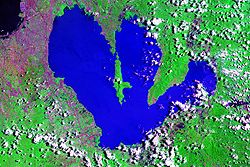 Talim Island with Mount Tagapo as seen from Los Baños pier at dusk | |
| Geography | |
|---|---|
| Location | Laguna de Bay |
| Coordinates | 14°21′7″N121°13′54″E / 14.35194°N 121.23167°E |
| Administration | |
| Region | Calabarzon |
| Province | Rizal |
| Municipalities | |
| Demographics | |
| Population | 40,018 (as of 2020) |
| Additional information | |
 | |
Talim Island is the largest lake island in Laguna de Bay, the largest lake in the Philippines. The island is inside the Province of Rizal, under the control of two municipalities, with the western side is part of Binangonan, while the eastern side is part of Cardona. The island is volcanic in origin and forms the southwest rim of the Laguna Caldera. Volcanism after the formation of the caldera created the maars and volcanic craters at the southern end of the island, [1] the largest of which is a 3-kilometre (1.9 mi) crater surrounding Barangays Balibago and Tuna. [2]



